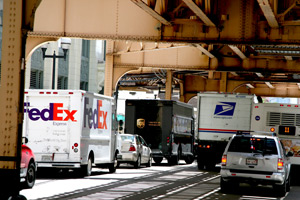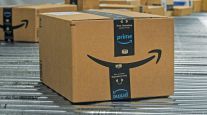Holiday Online Orders Have Shippers in Highest Gear

The holiday shipping season is in overdrive now, with the next two Mondays expected to be among the busiest of the year.
Typically, Cyber Monday (the Monday after Thanksgiving) and the next couple of Mondays require shipping facilities in Chicago and throughout the world to double their average daily volume, according to FedEx Corp. That means on the busiest days they will be handling 20 million shipments worldwide.
For the holiday period stretching from Black Friday to Christmas Eve, the company expects to move 317 million shipments. For the Chicago facility ,about 21,000 packages came through the facility Dec. 7, operations manager Michael Cabanski said.
The Chicago facility, with about 290 employees, is the fourth-largest station in the country and one of eight in the metro area stretching as far as Waukegan. FedEx is headquartered in Memphis, Tennessee.
The rise of shopping online is a major contributor to the increase. The National Retail Federation estimates more people shopped online than in stores during the Thanksgiving shopping weekend — 103 million versus 102 million.
FedEx is anticipating that the volume of holiday shipments will be up 12.4% this year. The U.S. Postal Service is expecting an increase of 10.5% over last year's volume as it delivers about 15.5 billion cards, letters and packages between Thanksgiving and New Year's Eve.
Processing holiday packages "is a marathon, not a sprint," FedEx's Cabanski said.
He eyed thousands of packages arriving from O'Hare International Airport in containers that came from six planes that landed overnight. The Chicago facility starts moving packages out of 6,000-pound containers at 5 a.m. each day. By 8 a.m., packages have moved to trucks for delivery. If they're late unloading containers, extra expense is set in motion, and snow can ruin the schedule, Cabanski said.
The goal is to get everything to its destination by 3 p.m. Going later means expense.
"The longer you are out there, the more fuel" FedEx uses, Cabanski said. Pacing "along a very structured time schedule" is the key each day.
In September, the company reported revenue down 4% for the first quarter of 2016 for its FedEx Express segment due primarily to lower fuel surcharges and international currency impacts, the company said. Yet, It reported U.S. volume was up 1%.
Analysts watching the company closely for hints of the strength of U.S. consumers have raised concerns about slowdowns in retail store traffic. FedEx stock is down about 8% for the year, while its chief rival, UPS Inc., is down almost 5%. Morningstar's index of shipping and logistics companies has declined about 6% as many transportation companies have been hit by weakness in the global economy.
During FedEx's earnings call in September, Executive Vice President T. Michael Glenn said he expected a need for 55,000 additional employees during the holiday shopping season — an increase of about 10% over last year. UPS has said it will add about 95,000 holiday workers, in line with last year.
Both companies have been adjusting to the new environment for holiday shopping, with store shopping less popular and cybershopping growing briskly each year. In 2013, the major shipping companies were unprepared for the onslaught of packages from Amazon .com Inc. and other online shopping venues. Recently, Amazon began to do deliveries of its own, throwing another wrinkle into planning by the major shipping companies.
Lately, the volume of activity reportedly has been so intense at Amazon's Robbinsville, New Jersey, facility that traffic in the neighborhood near the plant has been grinding to a halt. About 4,000 employees drive in and out of the facility.




